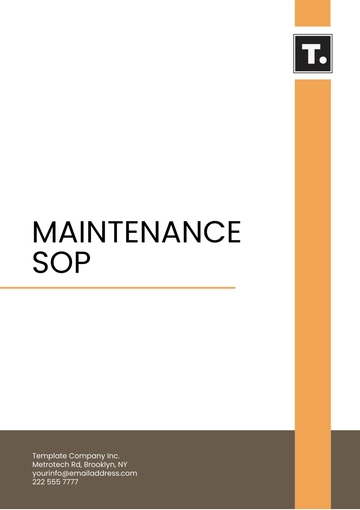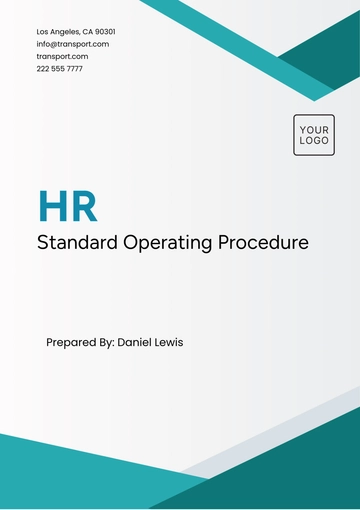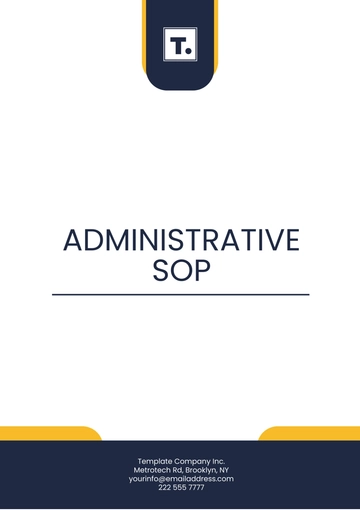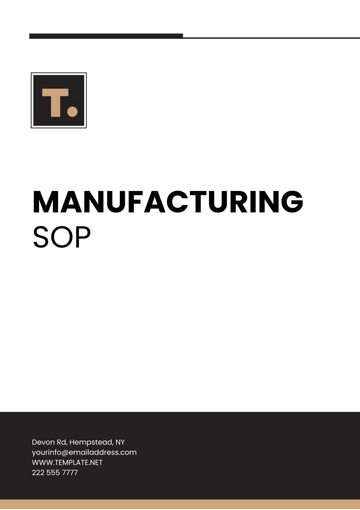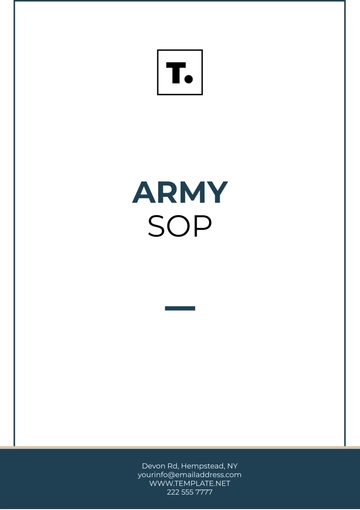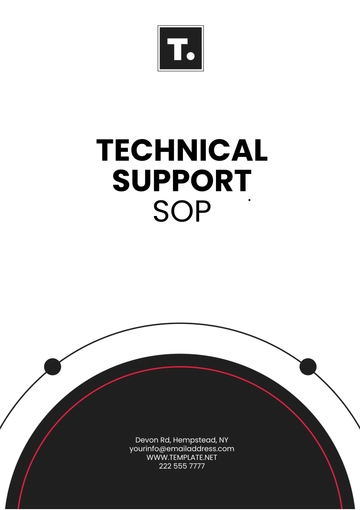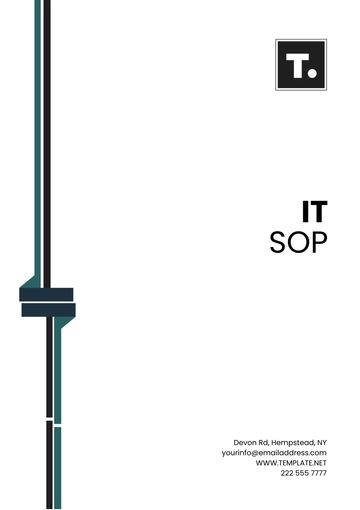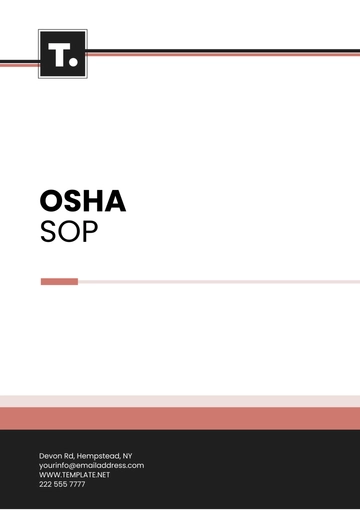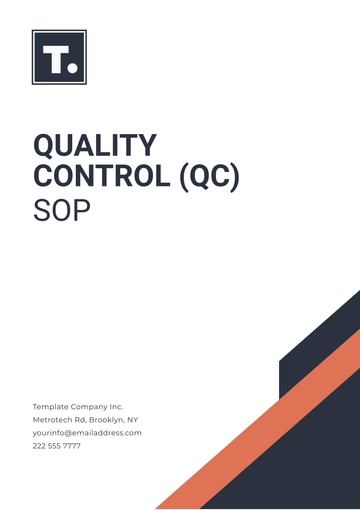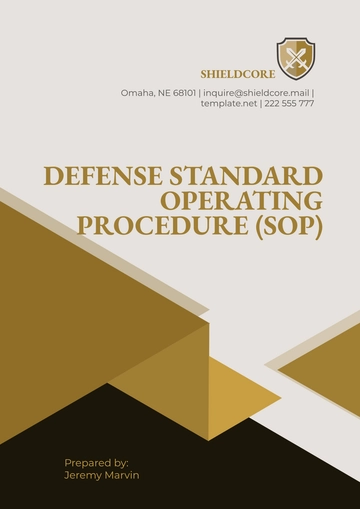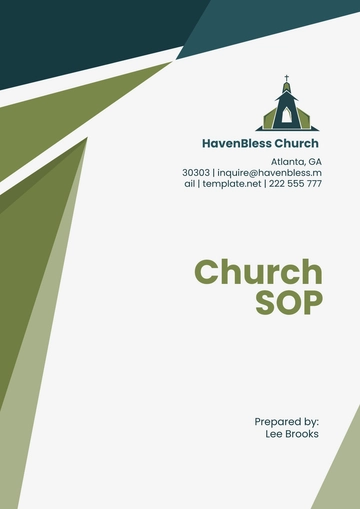Free Agriculture Equipment SOP
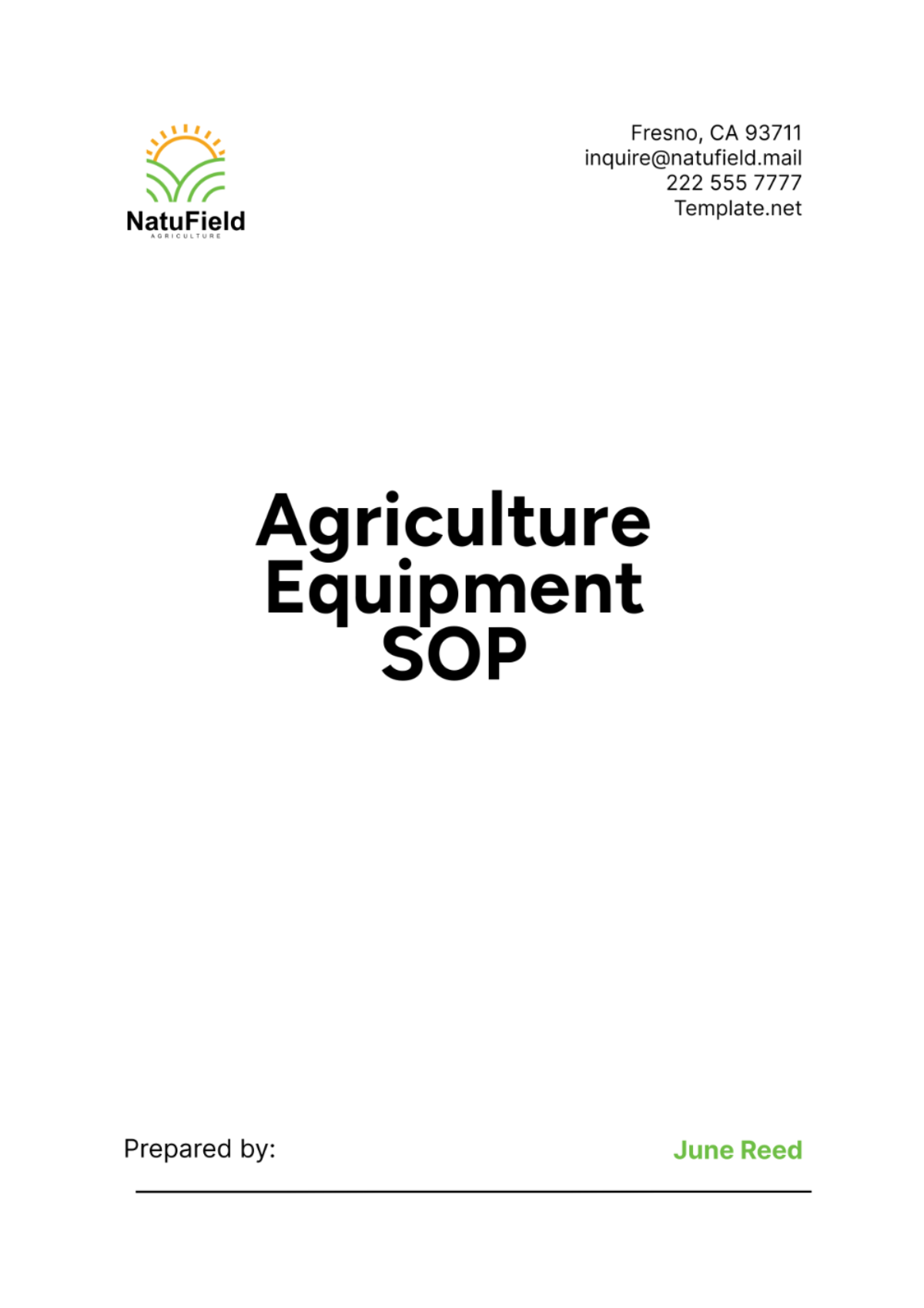
1. Introduction
The main objectives of [Your Company Name]'s Agriculture Equipment SOP are to ensure the safe and efficient operation of all agricultural machinery and tools. We aim to extend the lifespan of our equipment through regular maintenance and proper usage. Our SOPs are designed to minimize downtime and increase productivity by providing clear and detailed guidelines for equipment handling.
Additionally, we seek to enhance the skills and knowledge of our staff through consistent training and adherence to best practices. Finally, we strive to maintain compliance with all relevant safety regulations and industry standards, ensuring a safe working environment for all employees.
2. Safety Guidelines
Ensure operational safety with comprehensive guidelines. From Personal Protective Equipment (PPE) protocols to rigorous Safety Checklists, our commitment is to safeguarding our team and equipment.
2.1 Personal Protective Equipment (PPE)
All employees are required to wear appropriate PPE when operating agricultural machinery and tools. The following PPE is mandatory:
PPE Item | Description/Use | Required Conditions | Inspection Frequency |
|---|---|---|---|
Gloves | Insulated, cut-resistant gloves for handling machinery. | Must be worn during operation of machinery. | Daily before use |
Safety Glasses | Impact-resistant glasses to protect against flying debris. | Required whenever operating power tools. | Daily before use |
Steel-Toed Boots | Sturdy footwear with steel caps for foot protection. | Essential for all field and workshop work. | Daily before use |
Ear Protection | Earplugs or earmuffs to reduce noise exposure. | Required when operating loud machinery. | Daily before use |
Respiratory Masks | Dust masks or respirators for protection against dust and chemicals. | Essential during spraying or handling chemicals. | Daily before use |
Note: Ensure PPE fits properly and is in good condition. Replace worn or damaged items promptly.
2.2 Safety Checklists
Before operating agricultural machinery and tools, employees must conduct thorough safety checks. Below is the safety checklist format:
Item | Check | Action if Issue Found | Inspection Frequency | |
|---|---|---|---|---|
Brakes | Ensure brakes are functional and responsive. | Test by applying brakes under load. | Before each use | |
Steering | Check steering system for smooth operation. | Turn wheels to full lock and back. | Before each use | |
Lights | Verify proper functioning of all lights. | Test headlights, brake lights, and signals. | Before each use | |
Fluid Levels | Check engine oil, hydraulic fluid, and coolant levels. | Top up fluids to recommended levels. | Daily before use | |
Tire Pressure | Inspect tire pressure and condition. | Adjust pressure as per manufacturer's recommendation. | Before each use | |
Belts and Chains | Inspect belts and chains for wear and tension. | Replace or adjust if loose or damaged. | Weekly |
Procedure: Perform checks at the start of each shift or when equipment is handed over. Document and report any defects immediately to the maintenance team for repair.
3. Equipment Operation
Operate with precision using our detailed procedures. From Pre-Operational Checks ensuring equipment readiness to strict adherence to Operating Procedures, we ensure efficiency and safety.
3.1 Pre-Operational Checks
Before using any equipment, operators must perform a thorough inspection to ensure all components are in proper working order. Below is the format for pre-operational checks:
Check Item | Description/Action | Action if Issue Found | Inspection Frequency |
|---|---|---|---|
Fluid Levels | Check engine oil, hydraulic fluid, and coolant levels. | Top up fluids to recommended levels. | Before each use |
Fuel | Ensure an adequate amount of fuel is present. | Refuel if necessary. | Before each use |
Filters | Inspect air and fuel filters for cleanliness and clogging. | Replace if dirty or clogged. | Weekly or as needed |
Belts and Chains | Inspect belts and chains for wear, tension, and alignment. | Adjust or replace if necessary. | Weekly or as needed |
Lubrication Points | Apply grease to designated lubrication points. | Ensure all moving parts are well-lubricated. | Weekly or as recommended |
Procedure: Operators should visually inspect each component, operate controls to check functionality, and conduct a test run in a safe area before starting work.
3.2 Operating Procedures
Follow the manufacturer’s guidelines for operational procedures, ensuring all safety protocols are strictly adhered to. Below is the format for operating procedures:
Procedure Step | Description/Action | Safety Considerations |
|---|---|---|
Start-Up Sequence | Turn ignition key or press start button according to the manufacturer's instructions. | Ensure area is clear of obstructions. |
Operational Controls | Familiarize with and operate controls as per equipment manual. | Use safety interlocks if applicable. |
Operating Conditions | Check environmental factors such as terrain and weather conditions. | Adjust operation accordingly. |
Shut-Down Procedure | Turn off engine, engage parking brake, and secure equipment. | Follow cool-down procedures for hot components. |
Maintenance Post-Operation | Clean equipment, inspect for damage, and report any issues. | Store equipment in designated area. |
Note: Operators must receive training on equipment operation and regularly review and update procedures to reflect any changes in equipment or safety standards.
4. Maintenance Schedule
Maintain peak performance with meticulous care. Our Daily Maintenance ensures readiness, while Monthly Maintenance prevents issues, ensuring equipment longevity and reliability.
4.1 Daily Maintenance
Operators are required to perform daily maintenance tasks to ensure equipment readiness and safety. Below is the expanded format for daily maintenance:
Task | Completed | Action if Issue Found | Inspection Frequency |
|---|---|---|---|
Check fluid levels | Engine oil, hydraulic fluid, coolant | Top up fluids to recommended levels. | Before each use |
Inspect tires | Tire pressure, condition | Adjust pressure, replace if necessary. | Before each use |
Grease fittings | Lubricate moving parts | Apply grease to points as needed. | Daily or as recommended |
Visual inspection | Overall equipment condition | Report any damage or abnormalities. | Before each use |
Battery check | Battery charge, terminals | Clean terminals, charge if low. | Weekly |
Safety system test | Test safety features (e.g., emergency stop) | Verify functionality under load. | Weekly |
Clean air filters | Inspect and clean air filters | Replace if dirty or clogged. | Monthly or as needed |
Procedure: Perform these checks before starting operations each day to ensure equipment reliability and safety.
4.2 Monthly Maintenance
Monthly maintenance involves a thorough inspection to identify and address potential issues before they escalate. Below is the expanded format for monthly maintenance:
Task | Description/Action | Action if Issue Found | Inspection Frequency |
|---|---|---|---|
Belt inspection | Check for wear, tension | Adjust tension, replace if necessary. | Monthly or as recommended |
Hose inspection | Inspect for leaks, wear | Replace if cracked or damaged. | Monthly or as recommended |
Bearing inspection | Check for wear, lubrication | Grease or replace as needed. | Monthly or as recommended |
Electrical system inspection | Inspect wiring, connections | Repair or replace damaged components. | Quarterly |
Hydraulic system check | Check for leaks, fluid level | Top up fluids, repair leaks as needed. | Monthly or as recommended |
Blade and cutter inspection | Inspect for sharpness, wear | Sharpen or replace as necessary. | Monthly or as recommended |
Calibration check | Verify accuracy of sensors and gauges | Calibrate according to manufacturer specs. | Bi-annually |
Procedure: Conduct these checks monthly to ensure equipment longevity and prevent breakdowns during operation.
Regular maintenance is crucial for maximizing equipment lifespan, minimizing downtime, and ensuring safe operation in agricultural settings. These expanded tables provide comprehensive guidance for thorough equipment care and maintenance.
5. Training and Skill Enhancement
Empower our team with essential knowledge. Initial Training sets the foundation, while Ongoing Training updates skills, ensuring expertise in equipment operation and safety protocols.
5.1 Initial Training
All new employees must undergo a mandatory training program covering basic operational and safety procedures for agricultural equipment. Below is the expanded format for initial training:
Training Topic | Description/Action | Training Content |
|---|---|---|
Equipment Familiarization | Introduction to various types of agricultural machinery and tools | Demonstration of basic controls and functions. |
Safety Procedures | PPE requirements, emergency protocols | Hands-on practice in safe handling techniques. |
Operational Guidelines | Manufacturer's guidelines, maintenance basics | Classroom instruction and practical exercises. |
Field Practices | Practical field exercises | Supervised operation and simulation scenarios. |
Assessment | Evaluation of understanding and proficiency | Written test and practical assessment. |
Procedure: Conduct initial training for all new hires before they start operating equipment independently. Provide certificates upon successful completion.
5.2 Ongoing Training
Regular training sessions will be conducted to update staff on new equipment and procedures, as well as refreshers on existing guidelines. Below is the expanded format for ongoing training:
Training Topic | Description/Action | Training Content |
|---|---|---|
New Equipment Introductions | Introduction to newly acquired machinery and technologies | Hands-on practice and troubleshooting exercises. |
Safety Refresher | Review of safety protocols and updates | Case studies and scenario-based training. |
Advanced Techniques | Specialized operations and efficiency techniques | Workshops and demonstrations by experts. |
Regulatory Updates | Changes in safety regulations and compliance requirements | Legal updates and Q&A sessions with experts. |
Skill Development | Improving operational skills and efficiency | Simulation exercises and peer feedback sessions. |
Procedure: Schedule ongoing training sessions regularly throughout the year. Keep records of attendance and topics covered for compliance and performance evaluation purposes.
6. Compliance and Record-Keeping
Adhere to regulations with diligence. From Regulatory Compliance ensuring safety standards to meticulous Record Maintenance for accountability, we uphold operational integrity and regulatory excellence.
6.1 Regulatory Compliance
[Your Company Name] is committed to adhering to all local, state, and federal regulations regarding the safe operation of agricultural equipment. Below is the expanded format for regulatory compliance:
Regulatory Requirement | Description/Action | Compliance Procedure |
|---|---|---|
Safety Standards | Adherence to OSHA, EPA, and local safety regulations | Conduct regular audits and inspections. |
Equipment Certification | Ensure all equipment meets regulatory standards | Maintain certification records for each unit. |
Operator Licensing | Valid licenses and certifications for all equipment operators | Verify and document licenses annually. |
Environmental Compliance | Proper handling of fuels, chemicals, and waste | Implement spill prevention and cleanup plans. |
Training Requirements | Mandatory training on safety and operational procedures | Document training sessions and employee certifications. |
Procedure: Assign a compliance officer to oversee adherence to regulations and conduct regular updates to policies and procedures as regulations change.
6.2 Record Maintenance
Accurate records of maintenance, training, and inspections must be kept and stored securely for a minimum of five years. Below is the expanded format for record maintenance:
Record Type | Description/Action | Storage Requirements |
|---|---|---|
Maintenance Records | Details of all equipment maintenance activities | Digital or physical files, organized by equipment |
Training Records | Documentation of all training sessions and certifications | Secure database or filing system |
Inspection Reports | Reports from daily, monthly, and annual equipment checks | Easily accessible for audits and reviews |
Compliance Documents | Certificates, permits, licenses | Organized by type and expiration date |
Incident Reports | Documentation of any accidents or near misses | Confidential records, accessible to management |
Procedure: Designate a records manager to oversee documentation, ensure compliance with retention policies, and facilitate access for audits or regulatory reviews.
Maintaining comprehensive and organized records is essential for demonstrating compliance with regulations, ensuring safety, and supporting operational efficiency in agricultural equipment management.
7. Conclusion
Adherence to this Standard Operating Procedure (SOP) is paramount for maintaining the safe, efficient, and productive operation of all agricultural equipment at [Your Company Name]. By strictly following these guidelines, our commitment to safety and operational excellence remains steadfast. Regular inspections, meticulous maintenance, and ongoing training sessions ensure that our equipment operates at peak performance levels, minimizing downtime and enhancing operational efficiency.
Consistent adherence to these SOPs not only fosters a safe working environment but also reinforces our dedication to regulatory compliance and environmental stewardship. By upholding these standards, we mitigate risks associated with equipment failure and ensure compliance with local, state, and federal regulations governing agricultural operations. Our proactive approach to safety and maintenance not only protects our workforce but also supports the sustainability and growth of our operations over the long term.
Therefore, by implementing and strictly following these SOPs, [Your Company Name] demonstrates its commitment to operational excellence, safety, and regulatory compliance in the agricultural sector. This approach not only safeguards our employees and equipment but also reinforces our position as a responsible and reliable industry leader. Through continuous improvement and adherence to best practices, we aim to achieve continued success while contributing positively to our community and environment.
- 100% Customizable, free editor
- Access 1 Million+ Templates, photo’s & graphics
- Download or share as a template
- Click and replace photos, graphics, text, backgrounds
- Resize, crop, AI write & more
- Access advanced editor
Optimize your agricultural operations with Template.net's Agriculture Equipment SOP Template. This fully customizable and editable template ensures streamlined procedures, enhancing efficiency and safety. Easily editable in our Ai Editor Tool, it enables personalized adjustments to fit your specific needs. Elevate your operational standards and enhance productivity effortlessly. Start improving your processes with this essential resource today!




